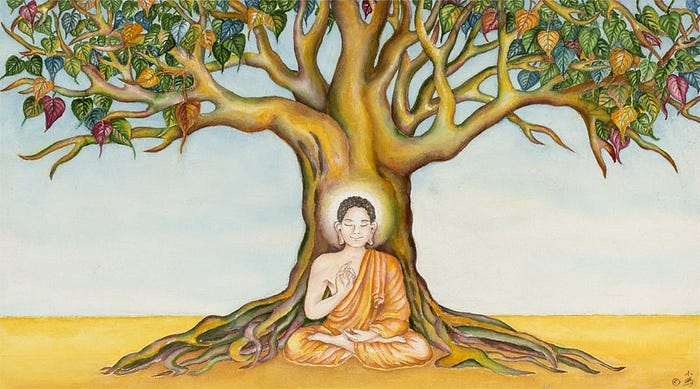Bodhi: The Tree of Enlightenment

The Bodhi tree (scientific name Ficus religiosa), is commonly known as Sacred fig. Bo tree or pipal tree is a species of banyan fig native to Nepal, India, Southwest China and Indochina east to Vietnam. This is a large tree with a height of up to 30m tall and the diameter of its trunk will be up to 3m.
Leaves of the Bodhi tree are heart-shaped and have a distinctive long tip. They are 10–17 cm long and 8–12 cm broad, with a 6–100 cm petiole. The fruit is a small fig in green ripening purple colour with 1–1.5 cm in diameter. Followers of Hinduism, Jainism and Buddhism consider this plant as sacred and hence they are known as “Sacred fig”
Bodhi tree is one of the earliest Buddhist symbols and objects of admiration. According to the Buddhist scriptures, people asked Buddha whom should they pay reference to when he was absent and he replied that they ought to respect a Bodhi tree. The Bodhi trees have been worshipped by Buddhist followers and are planted in Buddhist temple gardens all around the world. They remind us of the relation of forest and the Buddhist tradition and the dependence of our lives on nature and to be kind to all living beings.
As per history, Budha attained the supreme enlightenment while sitting under the Bo tree in Bodh Gaya, India. Hence, Bodhi trees play an important role in the origination of Buddhism.
Siddhartha Gautama was born into royalty within the village of Lumbini in present-day Nepal. He was grown up, married and had a son when he decided to leave the royal enclosure. When he left the palace, he saw, each for the first time, a sick man, an old man, and a corpse. By seeing them he learned that sickness, death and age were the unavoidable fate of human life. These fates cannot be avoided by anyone. As he travelled more, he saw many people suffering in all part of the world. So, he decided to join with religious men to search for a way to escape the inevitability of old age, sickness, and death. Even after searching for so many days didn’t get any answer. But he didn’t stop searching for them.
To seek a way to understand the meaning of life, Siddhartha went to Budhhagaya. Near a grove, he saw a huge Bodhi tree. He sat under the tree and silently vowed, “I will not leave this place until I find a way to end all sorrow of human life even if my flesh and blood dry up, leaving only skin and bones.” He sat there for forty-nine days. After seeing Siddhartha’s determination, Mara the evil one, tried to scare him into giving up his pursuit.
He started to send the vision of his beautiful daughters to Siddhartha’s mind to lure him into having selfish thoughts. But the Buddha’s goodness protected him from such evil forces. During this period, Siddhartha was able to see the true side of things. He had finally found the answer to his questions: “The cause of suffering is selfishness, greed, and stupidity. If people can remove these negative emotions from their life, they will be happy.” Siddhartha went into deep meditation during a full moon night. And when the morning star appeared in the eastern sky, he got enlighted and became Budha.
Budha stood up and gazed at the tree and expressed his gratitude for sheltering him. From then on, the Sacred fig is known as the Bodhi tree, the tree of Enlightenment.
To know more about We Grow Forest Foundation please visit our website https://wegrowforest.org/ or contact us at on 9778411911 or email at us plant@wegrowforest.org
